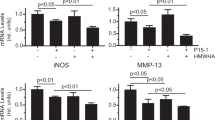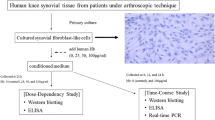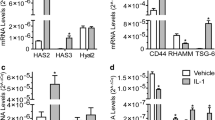Abstract
This study was aimed to examine the inhibitory mechanism of high molecular weight hyaluronan (HA) on nitric oxide (NO) production by NH2-terminal heparin-binding fibronectin fragment (FN-f) in rheumatoid arthritis (RA) chondrocytes. When the RA cartilage explants or the isolated RA chondrocytes in monolayer were incubated with FN-f, the fragment stimulated NO production with induction of inducible nitric oxide synthase (iNOS) and activation of p38 mitogen-activated protein kinase. Pretreatment with 2,700 kDa HA resulted in significant suppression of FN-f-stimulated NO production in RA cartilage as well as in chondrocyte monolayer cultures in association with iNOS down-regulation. Inhibition studies with p38 inhibitor indicated the requirement of p38 for FN-f-induced NO production. HA suppressed p38 activation by the FN-f, leading to a decrease in NO production. Immunofluorescence cytochemistry revealed HA association with intercellular adhesion molecule-1 (ICAM-1) and CD44. While the individual antibody to ICAM-1 or CD44 partially reversed HA effect on the FN-f action, both antibodies in combination completely blocked the HA effect. The present study clearly demonstrated that the high molecular weight of HA suppressed the FN-f-activated p38 via ICAM-1 and the CD44 in RA chondrocytes. HA could down-regulate the catabolic action of FN-f in RA joints through the mechanism demonstrated in this study.





Similar content being viewed by others
References
Miller DR, Mankin HJ, Shoji H et al (1984) Identification of fibronectin in preparations of osteoarthritic human cartilage. Connect Tissue Res 12:267–275
Jones KL, Brown M, Ali SY et al (1987) An immunohistochemical study of fibronectin in human osteoarthritic and disease-free articular cartilage. Ann Rheum Dis 46:809–815
Homandberg GA, Wen C, Hui F (1998) Cartilage damaging activities of fibronectin fragments derived from cartilage and synovial fluid. Osteoarthritis Cartilage 6:231–244
Xie DL, Meyers R, Homandberg GA (1992) Fibronectin fragments in osteoarthritic synovial fluid. J Rheumatol 19:1448–1452
Scott DL, Wainwright AC, Walton KW et al (1981) Significance of fibronectin in rheumatoid arthritis and osteoarthrosis. Ann Rheum Dis 40:142–153
Homandberg GA (1999) Potential regulation of cartilage metabolism in osteoarthritis by fibronectin fragments. Front Biosci 4:D713–D730
Homandberg GA, Meyers R, Xie DL (1992) Fibronectin fragments cause chondrolysis of bovine articular cartilage slices in culture. J Biol Chem 267:3597–3604
Yasuda T, Poole AR (2002) A fibronectin fragment induces type II collagen degradation by collagenase through an interleukin-1-mediated pathway. Arthritis Rheum 46:138–148
Yasuda T, Poole AR, Shimizu M et al (2003) Involvement of CD44 in induction of matrix metalloproteinases by a COOH-terminal heparin-binding fragment of fibronectin in human articular cartilage in culture. Arthritis Rheum 48:1271–1280
Yasuda T, Kakinuma T, Julovi SM et al (2004) COOH-terminal heparin-binding fibronectin fragment induces nitric oxide production in rheumatoid cartilage through CD44. Rheumatology (Oxford) 43:1116–1120
Gemba T, Valbracht J, Alsalameh S et al (2002) Focal adhesion kinase and mitogen-activated protein kinases are involved in chondrocyte activation by the 29-kDa amino-terminal fibronectin fragment. J Biol Chem 277:907–911
Kang Y, Eger W, Koepp H et al (1999) Hyaluronan suppresses fibronectin fragment-mediated damage to human cartilage explant cultures by enhancing proteoglycan synthesis. J Orthop Res 17:858–869
Yasuda T (2006) Cartilage destruction by matrix degradation products. Mod Rheumatol 16:197–205
Karin M, Liu ZG, Zandi E (1997) AP-1 function and regulation. Curr Opin Cell Biol 9:240–246
Garrington TP, Johnston GL (1999) Organization and regulation of mitogen-activated protein kinase signaling pathways. Curr Opin Cell Biol 11:211–218
Yasuda T, Julovi SM, Hiramitsu T et al (2004) Requirement of mitogen-activated protein kinase for collagenase production by the fibronectin fragment in human articular chondrocytes in culture. Mod Rheumatol 14:54–60
Yasuda T, Nakamura T (2007) Inhibition of nuclear factor-κB by hyaluronan in rheumatoid chondrocytes stimulated with COOH-terminal heparin-binding fibronectin fragment. Mod Rheumatol 17:391–397
Aruffo A, Stamenkovic I, Melnick M et al (1990) CD44 is the principal cell surface receptor for hyaluronate. Cell 61:1303–1313
McCourt PA, Ek B, Forsberg N et al (1994) Intercellular adhesion molecule-1 is a cell surface receptor for hyaluronan. J Biol Chem 269:30081–30084
Ostergaard K, Salter DM, Andersen CB et al (1997) CD44 expression is up-regulated in the deep zone of osteoarthritic cartilage from human femoral heads. Histopathology 31:451–459
Takagi T, Okamoto R, Suzuki K et al (2001) Up-regulation of CD44 in rheumatoid chondrocytes. Scand J Rheumatol 30:110–113
Springer TA (1990) Adhesion receptors of the immune system. Nature 346:425–434
Hopkins AM, Baird AW, Nusrat A (2004) ICAM-1: targeted docking for exogenous as well as endogenous ligands. Adv Drug Deliv Rev 56:763–778
Dustin ML, Rothlein R, Bhan AK et al (1986) Induction by IL-1 and interferon-γ: tissue distribution, biochemistry, and function of a natural adherence molecule (ICAM-1). J Immunol 37:245–254
Julovi SM, Yasuda T, Shimizu M et al (2004) Inhibition of interleukin-1β-stimulated production of matrix metalloproteinases by hyaluronan via CD44 in human articular cartilage. Arthritis Rheum 50:516–525
Shimizu M, Yasuda T, Nakagawa T et al (2003) Hyaluronan inhibits matrix metalloproteinase-1 production by rheumatoid synovial fibroblasts stimulated by proinflammatory cytokines. J Rheumatol 30:1164–1172
Hiramitsu T, Yasuda T, Ito H et al (2006) Intercellular adhesion molecule-1 mediates the inhibitory effects of hyaluronan on interleukin-1β-induced matrix metalloproteinase production in rheumatoid synovial fibroblasts via down-regulation of NF-κB and p38. Rheumatology (Oxford) 45:824–832
Julovi SM, Ito H, Hiramitsu T et al (2008) Hyaluronan inhibits IL-1β-stimulated collagenase production via down-regulation of phosphorylated p38 in SW-1353 human chondrosarcoma cells. Mod Rheumatol 18:263–270
Jalkanen S, Jalkanen M (1992) Lymphocyte CD44 binds the COOH-terminal heparin-binding domain of fibronectin. J Cell Biol 116:817–825
Arnett FC, Edworthy SM, Bloch DA et al (1988) The American Rheumatism Association 1987 revised criteria for the classification of rheumatoid arthritis. Arthritis Rheum 31:315–324
Yatabe T, Mochizuki S, Takizawa M et al (2009) Hyaluronan inhibits expression of ADAMTS4 (aggrecanase-1) in human osteoarthritic chondrocytes. Ann Rheum Dis 68:1051–1058
Dahl LB, Dahl IM, Laurent AE et al (1985) Concentration and molecular weight of sodium hyaluronate in synovial fluid from patients with rheumatoid arthritis and other arthropathies. Ann Rheum Dis 44:817–822
Whitmarsh AJ, Yang SH, Su MS et al (1997) Role of p38 and JNK mitogen-activated protein kinases in the activation of ternary complex factors. Mol Cell Biol 17:2360–2371
Ridley SH, Sarsfield SJ, Lee JC et al (1997) Actions of IL-1 are selectively controlled by p38 mitogen-activated protein kinase: regulation of prostaglandin H synthase-2, metalloproteinases, and IL-6 at different levels. J Immunol 158:3165–3173
Badger AM, Bradbeer JN, Votta B et al (1996) Pharmacological profile of SB203580, a selective inhibitor of cytokine suppressive binding protein/p38 kinase, in animal models of arthritis, bone resorption, endotoxin shock and immune function. J Pharmacol Exp Ther 279:1453–1461
Yasuda T (2007) Hyaluronan inhibits cytokine production by lipopolysaccharide-stimulated U937 macrophages through down-regulation of NF-κB via ICAM-1. Inflamm Res 56:246–253
Salter DM, Godolphin JL, Gourlay MS et al (1996) Analysis of human articular chondrocyte CD44 isoform expression and function in health and disease. J Pathol 179:396–402
Davies ME, Dingle JT, Pigott R et al (1991) Expression of intercellular adhesion molecule 1 (ICAM-1) on human articular cartilage chondrocytes. Connect Tissue Res 26:207–216
Davies ME, Sharma H, Pigott R (1992) ICAM-1 expression on chondrocytes in rheumatoid arthritis: induction by synovial cytokines. Mediat Inflamm 1:71
Toba T, Mizusawa N, Tajima G et al (1997) Upregulation of CD44 mRNA expression by interleukin-1β in cultured rabbit articular chondrocytes. J Bone Miner Metab 15:84–93
Lisignoli G, Grassi F, Zini N et al (2001) Anti-Fas-induced apoptosis in chondrocytes reduced by hyaluronan: evidence for CD44 and CD54 (intercellular adhesion molecule 1) involvement. Arthritis Rheum 44:1800–1807
Acknowledgments
This study was partly supported by the grant from Chugai Pharmaceutical Company.
Disclosures
None
Author information
Authors and Affiliations
Corresponding author
Rights and permissions
About this article
Cite this article
Yasuda, T. Hyaluronan inhibits p38 mitogen-activated protein kinase via the receptors in rheumatoid arthritis chondrocytes stimulated with fibronectin fragment. Clin Rheumatol 29, 1259–1267 (2010). https://doi.org/10.1007/s10067-010-1512-5
Received:
Revised:
Accepted:
Published:
Issue Date:
DOI: https://doi.org/10.1007/s10067-010-1512-5




